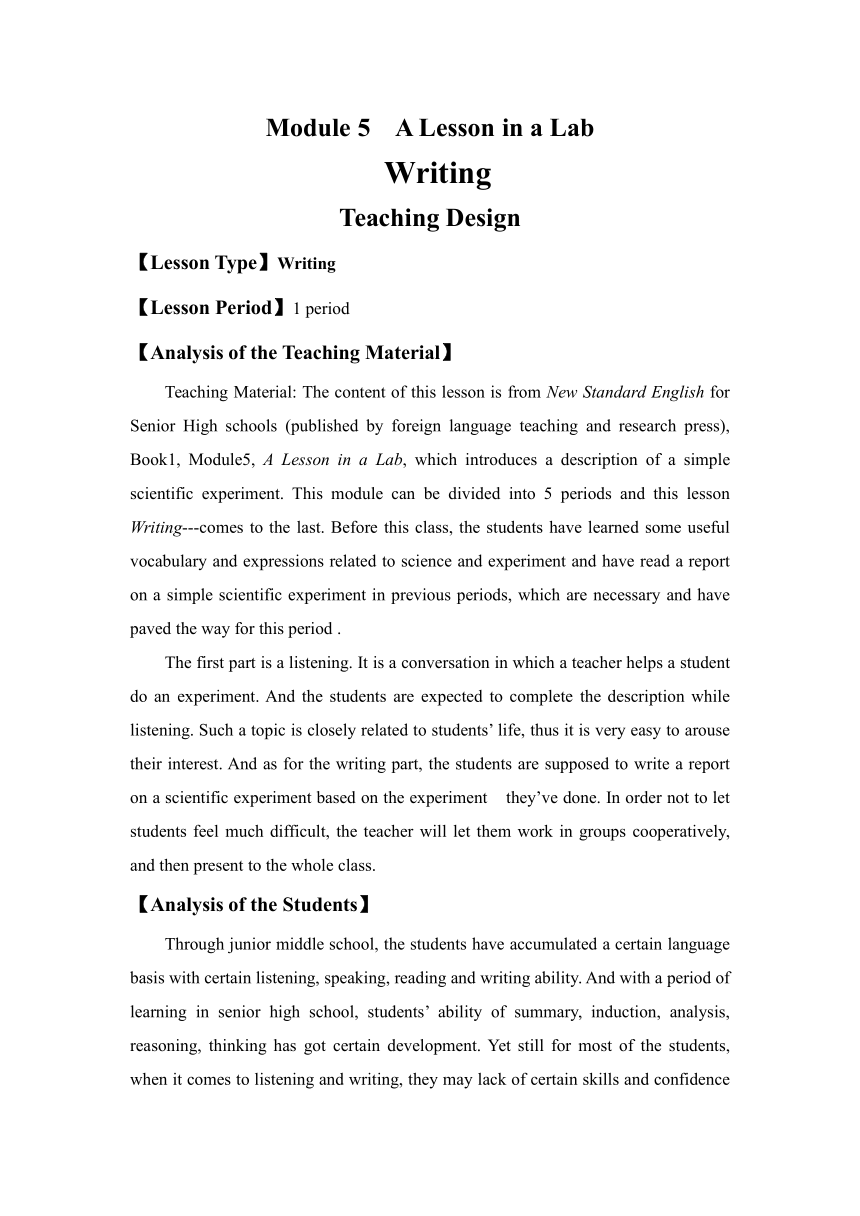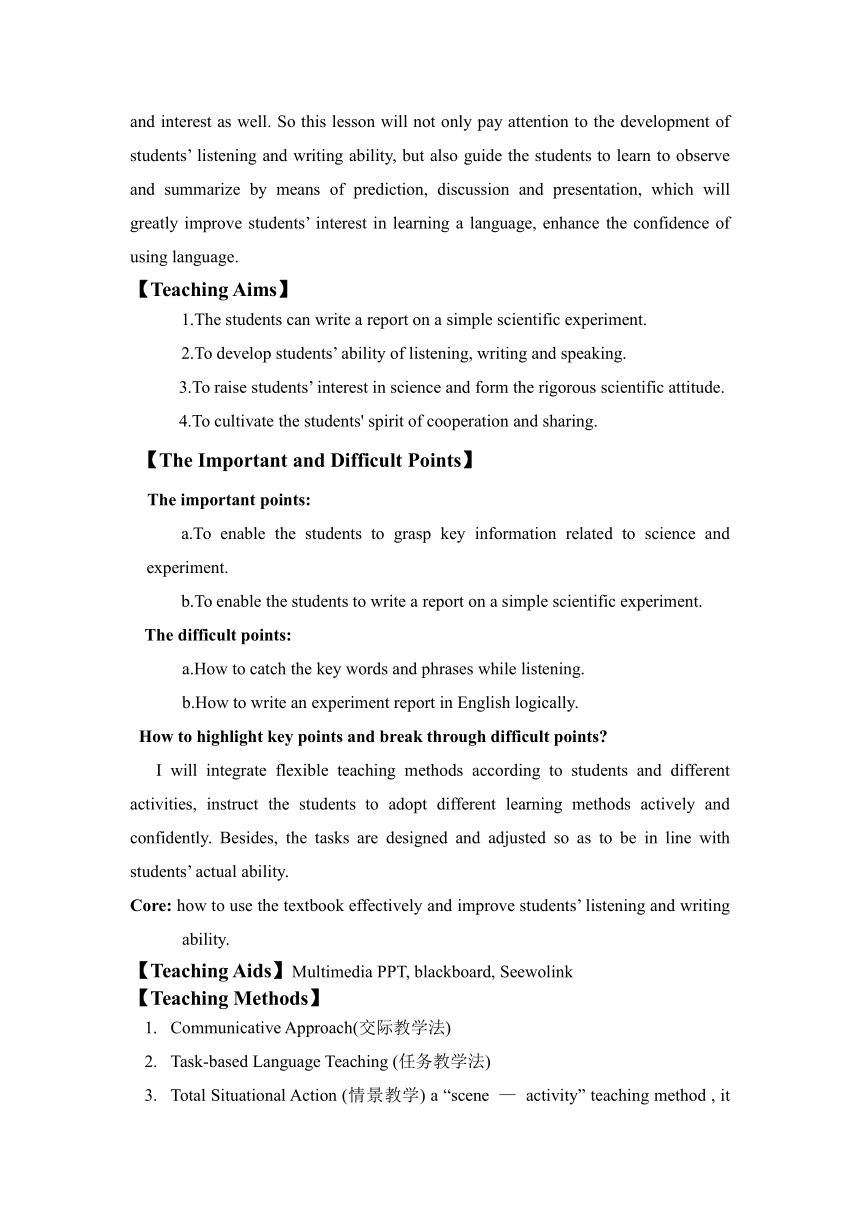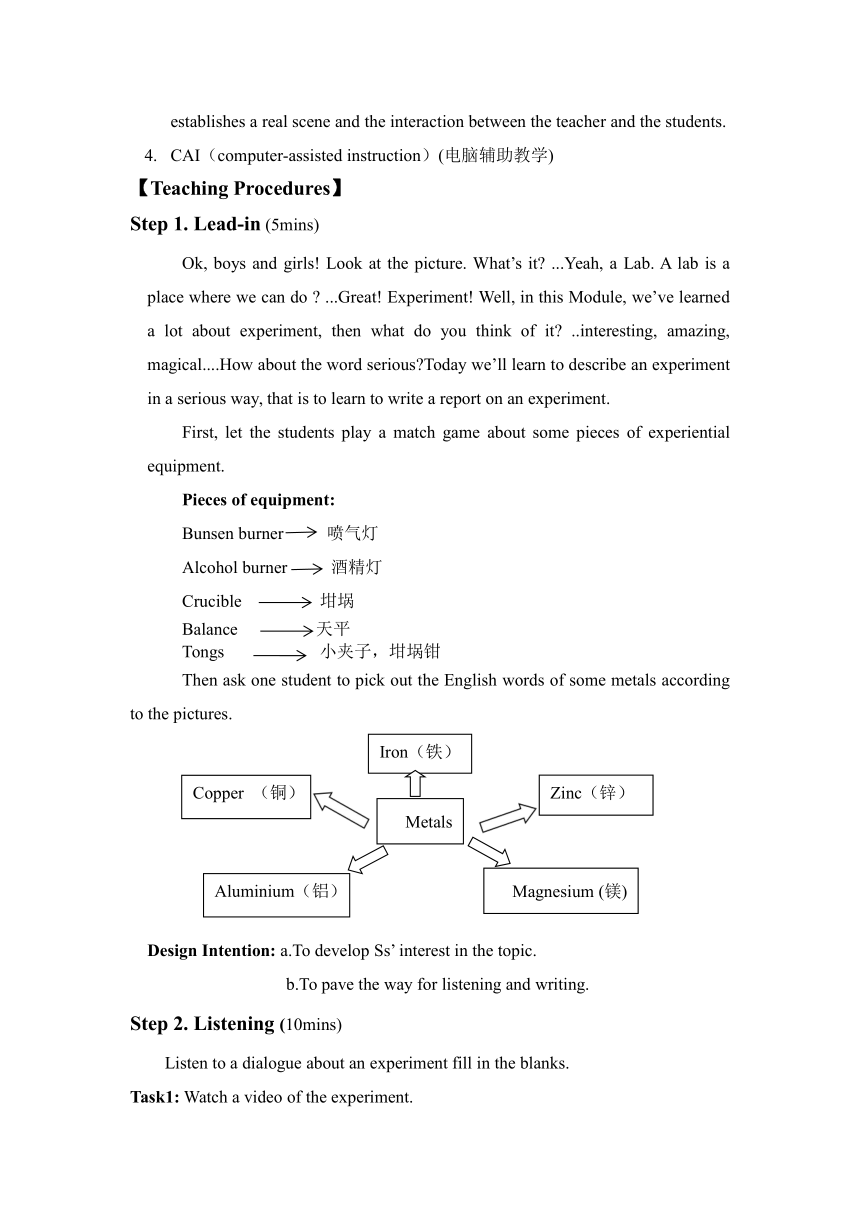高中英语外研版必修一Module 5 A Lesson in a Lab Writing教案
文档属性
| 名称 | 高中英语外研版必修一Module 5 A Lesson in a Lab Writing教案 |  | |
| 格式 | zip | ||
| 文件大小 | 337.7KB | ||
| 资源类型 | 教案 | ||
| 版本资源 | 外研版 | ||
| 科目 | 英语 | ||
| 更新时间 | 2022-01-24 15:44:02 | ||
图片预览



文档简介
Module 5 A Lesson in a Lab
Writing
Teaching Design
【Lesson Type】Writing
【Lesson Period】1 period
【Analysis of the Teaching Material】
Teaching Material: The content of this lesson is from New Standard English for Senior High schools (published by foreign language teaching and research press), Book1, Module5, A Lesson in a Lab, which introduces a description of a simple scientific experiment. This module can be divided into 5 periods and this lesson Writing---comes to the last. Before this class, the students have learned some useful vocabulary and expressions related to science and experiment and have read a report on a simple scientific experiment in previous periods, which are necessary and have paved the way for this period .
The first part is a listening. It is a conversation in which a teacher helps a student do an experiment. And the students are expected to complete the description while listening. Such a topic is closely related to students’ life, thus it is very easy to arouse their interest. And as for the writing part, the students are supposed to write a report on a scientific experiment based on the experiment they’ve done. In order not to let students feel much difficult, the teacher will let them work in groups cooperatively, and then present to the whole class.
【Analysis of the Students】
Through junior middle school, the students have accumulated a certain language basis with certain listening, speaking, reading and writing ability. And with a period of learning in senior high school, students’ ability of summary, induction, analysis, reasoning, thinking has got certain development. Yet still for most of the students, when it comes to listening and writing, they may lack of certain skills and confidence and interest as well. So this lesson will not only pay attention to the development of students’ listening and writing ability, but also guide the students to learn to observe and summarize by means of prediction, discussion and presentation, which will greatly improve students’ interest in learning a language, enhance the confidence of using language.
【Teaching Aims】
1.The students can write a report on a simple scientific experiment.
2.To develop students’ ability of listening, writing and speaking.
3.To raise students’ interest in science and form the rigorous scientific attitude.
4.To cultivate the students' spirit of cooperation and sharing.
【The Important and Difficult Points】
The important points:
a.To enable the students to grasp key information related to science and experiment.
b.To enable the students to write a report on a simple scientific experiment.
The difficult points:
a.How to catch the key words and phrases while listening.
b.How to write an experiment report in English logically.
How to highlight key points and break through difficult points
I will integrate flexible teaching methods according to students and different activities, instruct the students to adopt different learning methods actively and confidently. Besides, the tasks are designed and adjusted so as to be in line with students’ actual ability.
Core: how to use the textbook effectively and improve students’ listening and writing ability.
【Teaching Aids】Multimedia PPT, blackboard, Seewolink
【Teaching Methods】
Communicative Approach(交际教学法)
Task-based Language Teaching (任务教学法)
Total Situational Action (情景教学) a “scene — activity” teaching method , it establishes a real scene and the interaction between the teacher and the students.
CAI(computer-assisted instruction)(电脑辅助教学)
【Teaching Procedures】
Step 1. Lead-in (5mins)
Ok, boys and girls! Look at the picture. What’s it ...Yeah, a Lab. A lab is a place where we can do ...Great! Experiment! Well, in this Module, we’ve learned a lot about experiment, then what do you think of it ..interesting, amazing, magical....How about the word serious Today we’ll learn to describe an experiment in a serious way, that is to learn to write a report on an experiment.
First, let the students play a match game about some pieces of experiential equipment.
Pieces of equipment:
Bunsen burner 喷气灯
Alcohol burner 酒精灯
Crucible 坩埚
Balance 天平
Tongs 小夹子,坩埚钳
Then ask one student to pick out the English words of some metals according to the pictures.
Design Intention: a.To develop Ss’ interest in the topic.
b.To pave the way for listening and writing.
Step 2. Listening (10mins)
Listen to a dialogue about an experiment fill in the blanks.
Task1: Watch a video of the experiment.
Task 2: Listen to the conversation and complete the description (twice).
Aim: to find out if there is a change in weight when magnesium burns in the air.
Apparatus: Magnesium, Bunsen burner, a balance, a crucible
Method:First, put the magnesium in the crucible. Then, put the crucible on the balance and weigh it. Next, heat the magnesium. After that, light the Bunsen burner. Hold the crucible over it. Finally, weigh the magnesium again.
Result:It weighs a little more than before.
Conclusion: There is a change in weight when the Magnesium burns in air.
Design Intention: a.to practice students’ ability of listening for specific information;
b.to enable the students to get well prepared for writing.
Step 3. Writing (30mins)
Just now we have heard a description of a simple scientific experiment and we’ve also learned one in Reading and Vocabulary of this module, which shows us how iron reacts with air and with water . Do you remember Let’s recall the stages of a scientific experiment.
When we do an experiment, we should first of all have an aim. We should prepare some pieces of equipment and we should use proper method. We should find out the result and get a conclusion.
Task 1: Do an experiment together in groups of 8.(3mins)
Aim: To write a secret message with invisible ink.
Equipment: A lemon, a container, a pen , a piece of white writing paper, a candle and some matches.
Listen to the tape about the Method and follow.
Task 2: write a report on the experiment individually.(10mins)
Aim
The aim of this experiment is to...
Equipment
To carry out the experiment, you need the following things: ...
Method
First, ...Next, ... and...Then...After that,......Finally,...
Result: The message...
Conclusion: The message appears when you heat it because...
Task 3 (Evaluation): Share and discuss in groups and choose the best one to present to the whole class.(2mins)
Task 4: Group presentation(15mins)
Design Intention: a.to encourage students to take part in the learning activities and learn to be cooperative.
b.to practice students’ ability of writing and speaking.
Homework
Write a composition according to the following tips:
假如你是李华,你的美国笔友Peter 对中国菜非常感兴趣并且正在学做中国菜,写信询问你最喜欢的一道菜并请你介绍做法,请你就此给他回信。
内容包括:
1.你喜欢的一道菜;
2.介绍做法
3.欢迎Peter来访 。
注意:
1.词数100左右;
2.不得出现真实姓名和学校名称。
Blackboard Design
Blackboard design is the important points of this class.
Blackboard design should be tidy and beautiful.
Blackboard Design
Feedback:
As far as this class is concerned, it is effective. I integrate flexible teaching methods according to students and different activities. I try to stick to the Student-center theory and act as a director. Not only have the students improved their language skills in listening, speaking, reading , and writing, but also they have built a positive attitude towards science and scientific experiment. In the meantime, they have developed both autonomous learning ability and cooperative learning ability and confidence in learning English as well.
However, there also remains something to improve. On one hand, I should focus on "generating”, while fully preparing“presetting”. On the other hand, I should pay attention to “non-preset”, as the unexpected situation will accidentally arise in the class. Anyway, the teacher needs teaching wits to organize the class and make everything under control.
Writing
Teaching Design
【Lesson Type】Writing
【Lesson Period】1 period
【Analysis of the Teaching Material】
Teaching Material: The content of this lesson is from New Standard English for Senior High schools (published by foreign language teaching and research press), Book1, Module5, A Lesson in a Lab, which introduces a description of a simple scientific experiment. This module can be divided into 5 periods and this lesson Writing---comes to the last. Before this class, the students have learned some useful vocabulary and expressions related to science and experiment and have read a report on a simple scientific experiment in previous periods, which are necessary and have paved the way for this period .
The first part is a listening. It is a conversation in which a teacher helps a student do an experiment. And the students are expected to complete the description while listening. Such a topic is closely related to students’ life, thus it is very easy to arouse their interest. And as for the writing part, the students are supposed to write a report on a scientific experiment based on the experiment they’ve done. In order not to let students feel much difficult, the teacher will let them work in groups cooperatively, and then present to the whole class.
【Analysis of the Students】
Through junior middle school, the students have accumulated a certain language basis with certain listening, speaking, reading and writing ability. And with a period of learning in senior high school, students’ ability of summary, induction, analysis, reasoning, thinking has got certain development. Yet still for most of the students, when it comes to listening and writing, they may lack of certain skills and confidence and interest as well. So this lesson will not only pay attention to the development of students’ listening and writing ability, but also guide the students to learn to observe and summarize by means of prediction, discussion and presentation, which will greatly improve students’ interest in learning a language, enhance the confidence of using language.
【Teaching Aims】
1.The students can write a report on a simple scientific experiment.
2.To develop students’ ability of listening, writing and speaking.
3.To raise students’ interest in science and form the rigorous scientific attitude.
4.To cultivate the students' spirit of cooperation and sharing.
【The Important and Difficult Points】
The important points:
a.To enable the students to grasp key information related to science and experiment.
b.To enable the students to write a report on a simple scientific experiment.
The difficult points:
a.How to catch the key words and phrases while listening.
b.How to write an experiment report in English logically.
How to highlight key points and break through difficult points
I will integrate flexible teaching methods according to students and different activities, instruct the students to adopt different learning methods actively and confidently. Besides, the tasks are designed and adjusted so as to be in line with students’ actual ability.
Core: how to use the textbook effectively and improve students’ listening and writing ability.
【Teaching Aids】Multimedia PPT, blackboard, Seewolink
【Teaching Methods】
Communicative Approach(交际教学法)
Task-based Language Teaching (任务教学法)
Total Situational Action (情景教学) a “scene — activity” teaching method , it establishes a real scene and the interaction between the teacher and the students.
CAI(computer-assisted instruction)(电脑辅助教学)
【Teaching Procedures】
Step 1. Lead-in (5mins)
Ok, boys and girls! Look at the picture. What’s it ...Yeah, a Lab. A lab is a place where we can do ...Great! Experiment! Well, in this Module, we’ve learned a lot about experiment, then what do you think of it ..interesting, amazing, magical....How about the word serious Today we’ll learn to describe an experiment in a serious way, that is to learn to write a report on an experiment.
First, let the students play a match game about some pieces of experiential equipment.
Pieces of equipment:
Bunsen burner 喷气灯
Alcohol burner 酒精灯
Crucible 坩埚
Balance 天平
Tongs 小夹子,坩埚钳
Then ask one student to pick out the English words of some metals according to the pictures.
Design Intention: a.To develop Ss’ interest in the topic.
b.To pave the way for listening and writing.
Step 2. Listening (10mins)
Listen to a dialogue about an experiment fill in the blanks.
Task1: Watch a video of the experiment.
Task 2: Listen to the conversation and complete the description (twice).
Aim: to find out if there is a change in weight when magnesium burns in the air.
Apparatus: Magnesium, Bunsen burner, a balance, a crucible
Method:First, put the magnesium in the crucible. Then, put the crucible on the balance and weigh it. Next, heat the magnesium. After that, light the Bunsen burner. Hold the crucible over it. Finally, weigh the magnesium again.
Result:It weighs a little more than before.
Conclusion: There is a change in weight when the Magnesium burns in air.
Design Intention: a.to practice students’ ability of listening for specific information;
b.to enable the students to get well prepared for writing.
Step 3. Writing (30mins)
Just now we have heard a description of a simple scientific experiment and we’ve also learned one in Reading and Vocabulary of this module, which shows us how iron reacts with air and with water . Do you remember Let’s recall the stages of a scientific experiment.
When we do an experiment, we should first of all have an aim. We should prepare some pieces of equipment and we should use proper method. We should find out the result and get a conclusion.
Task 1: Do an experiment together in groups of 8.(3mins)
Aim: To write a secret message with invisible ink.
Equipment: A lemon, a container, a pen , a piece of white writing paper, a candle and some matches.
Listen to the tape about the Method and follow.
Task 2: write a report on the experiment individually.(10mins)
Aim
The aim of this experiment is to...
Equipment
To carry out the experiment, you need the following things: ...
Method
First, ...Next, ... and...Then...After that,......Finally,...
Result: The message...
Conclusion: The message appears when you heat it because...
Task 3 (Evaluation): Share and discuss in groups and choose the best one to present to the whole class.(2mins)
Task 4: Group presentation(15mins)
Design Intention: a.to encourage students to take part in the learning activities and learn to be cooperative.
b.to practice students’ ability of writing and speaking.
Homework
Write a composition according to the following tips:
假如你是李华,你的美国笔友Peter 对中国菜非常感兴趣并且正在学做中国菜,写信询问你最喜欢的一道菜并请你介绍做法,请你就此给他回信。
内容包括:
1.你喜欢的一道菜;
2.介绍做法
3.欢迎Peter来访 。
注意:
1.词数100左右;
2.不得出现真实姓名和学校名称。
Blackboard Design
Blackboard design is the important points of this class.
Blackboard design should be tidy and beautiful.
Blackboard Design
Feedback:
As far as this class is concerned, it is effective. I integrate flexible teaching methods according to students and different activities. I try to stick to the Student-center theory and act as a director. Not only have the students improved their language skills in listening, speaking, reading , and writing, but also they have built a positive attitude towards science and scientific experiment. In the meantime, they have developed both autonomous learning ability and cooperative learning ability and confidence in learning English as well.
However, there also remains something to improve. On one hand, I should focus on "generating”, while fully preparing“presetting”. On the other hand, I should pay attention to “non-preset”, as the unexpected situation will accidentally arise in the class. Anyway, the teacher needs teaching wits to organize the class and make everything under control.
